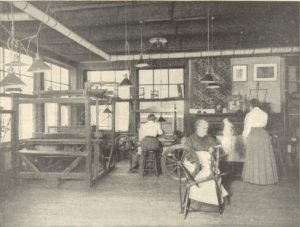Dr. Liane Malinowski is a Visiting Assistant Professor of English at Marist College. Her research explores Hull House residents’ rhetoric as it relates to their planning of domestic and urban spaces. This post derives from her recently-completed dissertation titled Civic Domesticity: Rhetoric, Women, and Space at Hull House, 1889-1910. Find her on Twitter @lianemalinowski.
My recent research on Addams and her Hull House colleagues focuses on how they reimagined urban space through visual, verbal, and material means. I was particularly interested in how women at Hull House claimed the authority to speak and write about urban space to local and national audiences, especially in the late-nineteenth century when women were not conferred the status of citizen, and rhetorical convention discouraged women from speaking in public.
I was motivated to take up this project in part because I think of Addams as an important but understudied speaker, writer, and theorist of concepts important to rhetorical studies, such as democracy, ethics, and memory. After surveying published and archival sources, I found that Addams and colleagues were prolific producers of experimental and hybrid texts that drew from parlor rhetoric traditions, domestic literature, social science genres, and city planning discourses. The Jane Addams Papers Project was a wonderful resource for studying documents related to Addams, Hull House, other residents, and the interconnected web of social welfare organizations in Chicago and beyond.
Regarding Hull House residents’ rhetorics of urban space, I argue Addams, along with Ellen Gates Starr, Julia Lathrop, Florence Kelley and others represented city spaces at a variety of scales as cosmopolitan, or nationally-diverse. These spaces included their West Side neighborhood and Hull House itself. An obvious example of this kind of representation is Florence Kelley’s “Nationalities Map,” in the collaboratively-written Hull House Maps and Papers, in which she visually locates families of varying national backgrounds in Hull House’s neighborhood.
Not only did residents represent urban space as cosmopolitan in documents, they also curated cosmopolitan spaces for rhetorical purposes. For example, upon founding Hull House, Addams and Starr curated it to reflect a cosmopolitan aesthetic through its artwork and artisan-made furniture and wares. They were motivated to do this in order to establish common ground with their immigrant neighbors with whom they believed they shared an interest in European art, music, and literature.[1]

Residents who represented spaces as cosmopolitan, however, did so with troubling political implications because they often spoke about and for their immigrant neighbors, and in so doing, flattened the specificity of their neighbors’ national identity in favor of emphasizing diversity. As part of this problematic history of claiming authority over cosmopolitan geographies, residents often extended their representations of urban space to include nationally-diverse people as objects of display. For example, in the early 20th century, Hull House residents curated a Labor Museum that displayed local immigrants performing artisan labor such as spinning textiles and weaving baskets. Residents also disseminated texts about the museum, such as the First Report of the Labor Museum in 1902. In this report, Addams argued that the Labor Museum presented an evolutionary narrative of work to audiences, and showed manual, pre-industrial labor as preceding industrial labor. She hoped younger people in the neighborhood would learn to appreciate their parents’ and grandparents’ artisan skills that were rendered obsolete by the industrial economy in Chicago. At the same time the museum performed this teaching function, I argue it also objectified immigrant artisans and their cultural artifacts by reinscribing older, neighborhood artisans as outside the contemporary moment by placing them and their labor prior to present industrial conditions. And, while Addams constructed herself as an authority over the entire museum and its message in the First Report of the Labor Museum, neighborhood women were figured as objects of display through photographs, captioned to suggest they are representatives of different kinds of foreign womanhood (the captions read “Italian Woman,” “Syrian Woman,” and “Irish Woman,” for example). Through the museum itself, and also texts such as the First Report, Addams and other residents participated in a trend of American women asserting their privilege to claim knowledge over foreign places and people as a way to join in public discourse about civic space and identity.[2]
After researching Hull House residents’ representations of cosmopolitan spaces in the 1890s and 1900s, I appreciate there is still much to explore about Addams’ rhetoric, especially surrounding her theorizing of how culture and class identities play a role in enabling and constraining communication. Based on my research experiences, I would encourage others undertaking study of Addams’ rhetoric to look across the JAPP Microfilm Edition, the JAPP Digital Edition, and traditional archives dedicated to Addams and Hull House in libraries. Each of these resources is organized in different ways, which can help researchers make new connections between documents. For example, some of the traditional, library archives file documents organized by author name, whereas the JAPP Microfilm Edition is largely filed by the kind of text produced at Hull House (letters, meeting minutes, financial records, etc), and the JAPP Digital Edition gets even more specific because it tags documents by key terms. Triangulating my search for documents across these resources was incredibly generative for my reading of Addams’ rhetoric.
[1] To gain a sense of Hull House’s cosmopolitan aesthetic, see Nora Marks’s “Two Women’s Work: The Misses Addams and Starr Astonish the West Siders,” Chicago Tribune. 19 May 1890, or the photographs included in Hull House Maps and Papers.1895. Urbana: UI Press, 2007.
[2] Kristin Hoganson’s Consumers’ Imperium: The Global Production of American Domesticity, 1865-1920. Chapel Hill: UNC Press, 2007, helped me understand the broader contours of American women’s claims to cosmopolitan geographies.


Are there good sources to get at the way Hull-House’s immigrant neighbors saw Addams and the other residents?
The Jane Addams Papers Project is a very good resource.